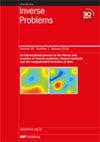用于 CT 重建的低分辨率先验平衡网络
IF 2
2区 数学
Q1 MATHEMATICS, APPLIED
引用次数: 0
摘要
在 X 射线计算机断层扫描中,已经研究了用于学习变分模型的展开方法。然而,对于不完整数据重建,如稀疏视图和有限角度问题,能量最小化问题梯度下降的展开法无法获得令人满意的结果。本文提出了一种有效的 CT 重建模型,其中引入了低分辨率图像作为不完整数据问题的正则化。接下来,我们利用深度均衡方法来展开梯度下降算法,从而构建出求解最小化模型的骨干网络架构。我们从理论上讨论了所提出的低分辨率先验均衡(LRPE)模型的收敛性,并提供了保证其收敛性的必要条件。我们提供了稀疏视图和有限角度重建问题的实验结果,证明我们的端到端 LRPE 模型在降噪、对比度-噪声比和边缘细节保留方面优于其他最先进的方法。本文章由计算机程序翻译,如有差异,请以英文原文为准。
Low-resolution prior equilibrium network for CT reconstruction
The unrolling method has been investigated for learning variational models in x-ray computed tomography. However, for incomplete data reconstruction, such as sparse-view and limited-angle problems, the unrolling method of gradient descent of the energy minimization problem cannot yield satisfactory results. In this paper, we present an effective CT reconstruction model, where the low-resolution image is introduced as a regularization for incomplete data problems. In what follows, we utilize the deep equilibrium approach to unfolding of the gradient descent algorithm, thereby constructing the backbone network architecture for solving the minimization model. We theoretically discuss the convergence of the proposed low-resolution prior equilibrium (LRPE) model and provide the necessary conditions to guarantee its convergence. Experimental results on both sparse-view and limited-angle reconstruction problems are provided, demonstrating that our end-to-end LRPE model outperforms other state-of-the-art methods in terms of noise reduction, contrast-to-noise ratio, and preservation of edge details.
求助全文
通过发布文献求助,成功后即可免费获取论文全文。
去求助
来源期刊

Inverse Problems
数学-物理:数学物理
CiteScore
4.40
自引率
14.30%
发文量
115
审稿时长
2.3 months
期刊介绍:
An interdisciplinary journal combining mathematical and experimental papers on inverse problems with theoretical, numerical and practical approaches to their solution.
As well as applied mathematicians, physical scientists and engineers, the readership includes those working in geophysics, radar, optics, biology, acoustics, communication theory, signal processing and imaging, among others.
The emphasis is on publishing original contributions to methods of solving mathematical, physical and applied problems. To be publishable in this journal, papers must meet the highest standards of scientific quality, contain significant and original new science and should present substantial advancement in the field. Due to the broad scope of the journal, we require that authors provide sufficient introductory material to appeal to the wide readership and that articles which are not explicitly applied include a discussion of possible applications.
 求助内容:
求助内容: 应助结果提醒方式:
应助结果提醒方式:


